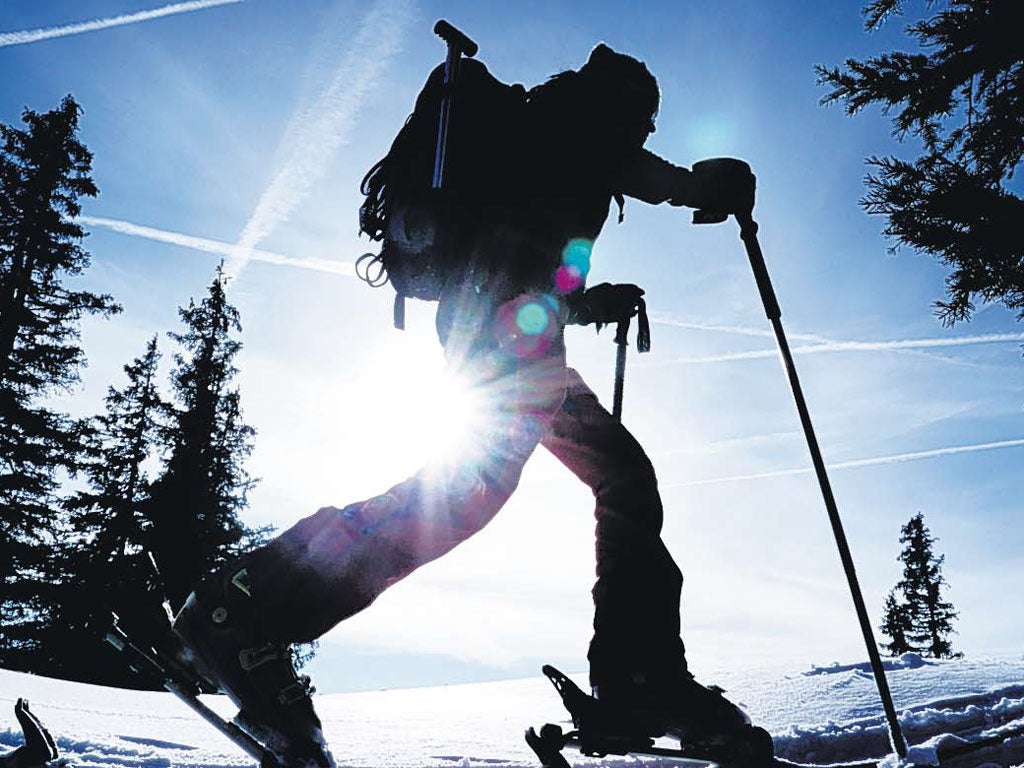The man who skis all day
Fabrics cut from a different cloth

Your support helps us to tell the story
From reproductive rights to climate change to Big Tech, The Independent is on the ground when the story is developing. Whether it's investigating the financials of Elon Musk's pro-Trump PAC or producing our latest documentary, 'The A Word', which shines a light on the American women fighting for reproductive rights, we know how important it is to parse out the facts from the messaging.
At such a critical moment in US history, we need reporters on the ground. Your donation allows us to keep sending journalists to speak to both sides of the story.
The Independent is trusted by Americans across the entire political spectrum. And unlike many other quality news outlets, we choose not to lock Americans out of our reporting and analysis with paywalls. We believe quality journalism should be available to everyone, paid for by those who can afford it.
Your support makes all the difference.These are exciting times in the world of technical fabrics. No, wait; don't turn the page. This might seem a dry subject, and it is, literally. But protecting skiers and boarders against moisture is important – and, on occasion, a matter of life and death.
Since its launch in the late 1970s, Gore‑Tex has been the market leader in "breathable" fabrics. Last season, however, it faced its first serious challenge, from a new fabric made by Polartec, named NeoShell. Gore‑Tex has responded: in the spring it will launch what it calls "a new generation of fabrics", with a product which – according to one clothing manufacturer's test – is 22 per cent more breathable than its predecessor.
It is simple enough to produce garments that are waterproof, and often a thick plastic jacket will do the job nicely; but for anyone working up a sweat – a keen skier or mountain climber, for example – such a barrier keeps moisture in as well as out. What is needed is a fabric that will allow moisture out through a membrane into the air.
Seriously high-performance outdoor clothing is for climbers and athletes: almost constantly on the move, they need as much breathability as they can get. In snowsports, however, much of the day is spent standing in queues and sitting on chairlifts, and at those times it's important to conserve body heat. This is the arena for the battle between Gore‑Tex and Polartec.
Most of what I know about technical fabrics I've learnt from Dave Whitlow, a buyer of mountain clothing for the Ellis Brigham retail chain for more than 25 years. Using as a reference next season's Gore‑Tex fabrics, Whitlow went through the key options. The new, top-of- the-range "Pro" fabric, he says, is designed for intense activities such as climbing and back-country skiing: "breathable, durable and expensive, it is intended for mountain professionals and will be adopted by high-performance clothing manufacturers such as Arc'teryx".
Gore‑Tex Active is thinner and lighter, designed for runners and cyclists, whose energy output is continuous. It is not so durable, says Whitlow, "and Gore will police its use so that it is not used for backpackers' garments". The third fabric is the classic Gore‑Tex, used in soft-shell garments aimed at stop/start leisure skiers who sometimes work up enough heat and moisture to test the membrane, but who want to retain heat when sitting on lifts and relaxing.
That is where NeoShell comes in. Polartec says its fabric has a much more progressive, constant form of breathability, drawing even very low levels of moisture out through its membrane. Does it really work? Whitlow says he got good reports in its first season "but it hasn't been around long enough to know how durable its superfine membrane is". There remains a debate, too, about the fabric's wind-chill protection.
Heavy marketing by Gore and Polartec has put other technical brands in the shade, but Whitlow doesn't dismiss them. Garments made with the Entrant fabric are good, he says, and can be 20 per cent cheaper than the Gore‑Tex equivalent. It's refreshing to know that you needn't splash out on clothing. Indeed, if you overspend you could end up too hot or too cold on the slopes.
Ice-cool in the city
For the newest ski scene you'll want to wear something a bit sharper than technical fabrics. And anyway, conditions are rarely extreme in Kensington. The winter theme popped up in London a couple of years ago with the temporary Alpine Lodge on the roof of Shoreditch's Clubhouse and the earlier opening of the Ice Bar off Regent Street, but this season ski style is becoming a prominent part of the city's nightlife.
Piste opened in a basement in Soho's Archer last month promising that "this winter things will be going downhill", and its alpine-retreat décor included the familiar old skis and snowshoes. This week Bodo's Schloss, "an authentic Austrian alpine restaurant, bar and disco", opened beneath the Royal Garden Hotel in Kensington; it has a DJ booth in a former ski-lift gondola and serves alpine-theme cocktails. And later this month in Bloomsbury the Montague Ski Lodge, featuring a ski rack, will re-open outside the Montague hotel (it made its debut last season).
It's hard to know what this is all about; and it's equally hard to believe that ski-themed basement bars can survive the summer.
Stephen Wood is executive editor of Condé Nast Traveller
Join our commenting forum
Join thought-provoking conversations, follow other Independent readers and see their replies
0Comments